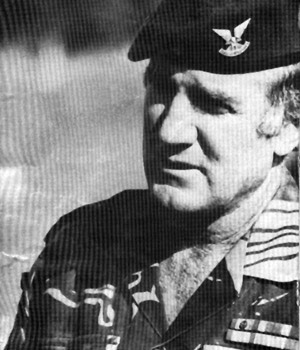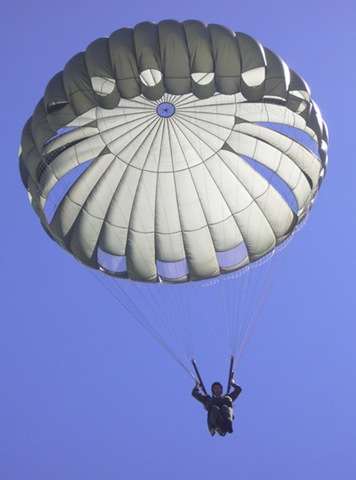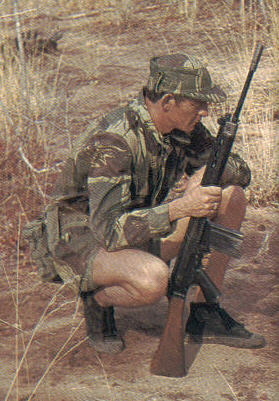Monday, December 20, 2010
Podcasts: Interview With Peter Stiff, Author Of The Covert War (Koevoet)
Wednesday, September 15, 2010
Military News: In Memory Of Ron Reid-Daly, Founder Of The Rhodesian Selous Scouts
I had posted this on the Facebook Page for FJ and I wanted to put this on the blog as part of the archives. Ron Reid-Daly and his Selous Scouts have been very influential to the thinking here at the blog, and I will always regret the fact that I was never able to meet the man.
One thing is for sure though, and that is his work and the accomplishments of the Selous Scouts will live on in military history books, and future discussions about modern warfare. I am constantly going back to the concepts of pseudo operations developed by this famous military unit as an element that is missing in today’s wars. That, and their version of light infantry and what being a ‘military scout’ really means continues to impress me to this day. Rest in peace to a warrior that did well. –Matt
——————————————————————

22nd September 1928 – 9th August 2010
This memorial website was created in the memory of Ronald Reid-Daly, born in Rhodesia, Salisbury on the 22nd September 1928 and passed away on the 9th August 2010, 81 years of age.
Biography
Full Name: Ronald Reid-Daly
Born: 22nd September 1928
Passed Away: 9th August 2010
Age: 81 years of age
Country: South Africa
Birth Place: Rhodesia, Salisbury
Colonel Ronald “Ron” Francis Reid-Daly founded and commanded the elite Selous Scouts special forces unit that fought during the Rhodesian Bush War
Born in South Africa, Reid-Daly entered military service in 1951 and served with the C (Rhodesia) Squadron of the British Special Air Service (SAS) in operations against insurgents in Malaya. Rising to the rank of Regimental Sergeant Major in the Rhodesian Light Infantry, he was later commissioned and achieved the rank of Captain. He retired from the Army in 1973.
Wednesday, May 5, 2010
Parachuting: Special Forces Get The New MC-6, Marines Get The New T-11
I perked up when I saw a story mentioning smokejumpers in the Stars and Stripes, and this is what they were talking about. Strategy Page just posted about it as well. The parachute that they were discussing is called the MC 6, and it has a different name in the smokejumpers. It is called the FS 14 canopy. It is a round (shape of the canopy) chute, and it is great for steep descents into tight jump spots surrounded by tall trees. It is also steerable, and you can get different sizes of chutes, depending on the weight and size of the jumper. I jumped a large when I was using the canopy in the Forest Service, and they are the ones who primarily use this canopy. I think the smallest spot surrounded by trees that I ever jumped with this parachute was the size of a small house. This parachute struggles in higher winds though, and I like a different parachute for that stuff.
When it comes to a great all around parachute for rough terrain parachuting, I preferred the RAM Air DC 7 canopy or square canopy. The MC 5 is the military equivalent. This parachute looks like the sport parachutes you see in the civilian world, and they are very nice.
This parachute is primarily used by the Bureau of Land Management and the Forest Service is slowly transitioning to this parachute. As we speak, they are doing cross training between the two organizations in order to gain proficiency. The BLM uses this parachute for the Great Basin in the western US, and up in Alaska. Both areas have higher winds, and big open areas. But both areas also have their mountains and trees to jump into. Having jumped rounds and squares (parachute types), I would have to go with squares as being the best all around parachute to use for all types of terrain. What I imagine the SF is doing, is just having the option to use either the MC 5 or the MC 6, depending upon the mission. That is smart, but hopefully they are proficient on both, and muscle memory doesn’t screw them up while using one parachute or the other. You definitely have to know each parachute and it’s deployment system very well in order to get a good parachuting strategy for getting on the ground safely and in rough terrain.
As for the T 11, it looks interesting, but I really cannot comment on it. Just as long as it is stable, easy to control, and gets the guys on the ground safely, then I am all for it.
Now what is exciting about the T-11 and the MC-6 is that both of these parachutes will make parachute operations a tad more safer, and make the option of airborne operations in war a little more feasible for future missions. Who knows, maybe the military might take another look at Fire Force type operations as a viable way of attacking enemies? Parachuting troops in places like Afghanistan, might be a safer option than flying in with helicopters or driving in via convoys. Parachuting also distributes the forces more. One missile or one IED can take out a multitude of troops in a helicopter or vehicle. Parachuting soldiers who are only exposed in the air for around 40 plus seconds, can make them very spread out and very hard to shoot.
And because the Taliban are such poor shots, I don’t think they could be very effective at shooting soldiers out of the sky as they parachute to the ground. Especially if there is a sniper team on the ground, or some airship circling around and lighting up any enemy forces that want to take a shot. With good night vision kit, and safer parachutes, night time operations might also be more feasible as well. I am sure airborne troops have thought about all of this stuff for our current wars, and it would be interesting to hear some of their ideas. You just don’t hear a lot about parachuting operations in this war, and it might be worth some further exploration. Especially if the military is going to invest millions of dollars into two new canopies for the troops, as well as cycle thousands of troops through airborne training. By the way, bravo to the guys at Paraflite for making some awesome parachutes. –Matt
—————————————————-

MC 6 parachute.

T 11 parachute.
Special Forces look to smoke jumpers for new parachutes
By Warren Peace
May 4, 2010
STUTTGART, Germany — Soldiers from the 1st Battalion, 10th Special Forces Group recently got a chance to try out the Army’s new MC-6 parachute, which they say will be put to good use when dropping into tight combat zones in Afghanistan.
The MC-6 is more maneuverable than the aging MC-1, which has been used by Special Forces soldiers for years, and the Stuttgart-based soldiers are the first unit in Europe to train with the new chute.
When searching for a new parachute that could drop them into a small landing area, Army Special Forces looked to the smoke jumpers, who are tasked with descending into the heart of Rocky Mountain forest fires, said David Roy, program leader for the MC-6.
“The U.S. forest services have been using this canopy for about 16 years now,” Roy said. “They use it to get into postage-size drop zones in the Rockies as they go to put out fires.”
Plus, the small drop zones and high altitudes of the Rocky Mountains are very similar to the conditions faced by airborne soldiers in Afghanistan, said Maj. Jason Morneault, assistant product manager for Program Manager Clothing and Individual Equipment for the Army.
Wednesday, January 27, 2010
Publications: Pseudo Operations And COIN: Lessons From Other Countries, By Dr. Lawrence E. Cline
If you have the time, check out this excellent paper. I loved it, because this is the kind of stuff that we need to be doing more of in this war. All it takes is one guy that we can use to deeply penetrate into Osama Bin Laden’s network or some drug cartel, and we could effectively dismantle those operations.
Dr. Cline gave a big mention to the Selous Scouts in this treatment of the subject, and brought up numerous other groups that had conducted pseudo operations in their wars.
Towards the end of the article, he builds a snowmobile out of all of this data from all of these other countries, and puts together a pretty good ‘lessons learned’ of how to do pseudo operations correctly:
1. Money counts.
2. The alternative to cooperation can be dire.
3. Coordination is critical.
4. Breaking guerrilla communications systems is a key tool.
5. Effectiveness of pseudo operations depends in large part on
the effectiveness of response forces.
6. The role of “turned” guerrillas is critical.
The two big components of turning enemy combatants it seems, is money and leveraging the choice of harsh incarceration or execution. That, and treating the captives really well in the beginning and having a really well planned system of turning these folks. It is quite clear though, that pseudo operations can be effective, and they are not impossible to do. It ain’t easy either, because if it was, everyone would be doing it successfully.
One of the things that is working against the US for pseudo operations, is that we detain terrorists with no chance of execution. There is nothing scary at all about our detention, despite what the media might have the public believe . If anything, terrorists want to go to Gitmo, so they can conduct propaganda campaigns for their cause while in detention. They love the idea that they can continue to live and wage jihad from a cell. The paradox though, is that they want to be martyred, so execution would be cool with them as well. So right there is one factor working against us for doing pseudo operations. Still, I think there are other incentives that we could use in order to turn these guys, and we should leave no stone unturned with a pseudo operation strategy.
Finally, the one theme that repeated throughout the paper, is that pseudo forces should focus primarily on information collection. When you involve them in more kinetic stuff, that tends to muck up everything. So whatever turned guerrillas or terrorists you use, it would probably be best to use them just to collect information and have a very flexible and quick reaction force to work off of that information. And to figure out a means of not accidently killing good guys or screwing up the pseudo operator’s operation. Lot’s to think about, but I really think this is the kind of stuff we need to do more of.
Now to put my industry hat on. Could a PMC offer these type of services? If a company was able to claim some kind of speciality in turning guerillas and terrorists, that is the kind of service that would really give states an advantage in their wars. Hell, I know non-states are already doing this kind of thing, and you see examples of it everywhere in this war. But if a company had a proprietary method for turning folks within the framework of international law, and within the laws of that host/contracting country, you could probably name your price. Especially if you were able to produce results. –Matt
—————————————————————–
Pseudo Operations and Counterinsurgency: Lessons from Other Countries
June 2005
Authored by Dr. Lawrence E. Cline
SUMMARY
Pseudo operations, in which government forces and guerrilla defectors portray themselves as insurgent units, have been a very successful technique used in several counterinsurgency campaigns. Pseudo teams have provided critical human intelligence and other support to these operations.
These operations, although of considerable value, also have raised a number of concerns. Their use in offensive missions and psychological operations campaigns has, at times, been counterproductive. In general, their main value has been as human intelligence collectors, particularly for long-term background intelligence or for identifying guerrilla groups that then are assaulted by conventional forces. Care must be taken in running these operations both to avoid going too far in acting like guerrillas, and in resisting becoming involved in human rights abuses.
Sunday, December 27, 2009
History: Tracker Combat Units–Zambezi Valley Manhunt, by David Scott-Donelan
This is some old school Soldier of Fortune material, but still really good. The Tracker Combat Units in Rhodesia were impressive, and as you can see below, this unit produce some interesting folks for their war. In particular, Andre Rabie and Allan Franklen, both founding members of the Selous Scouts.
And just so we don’t forget, I talked about David Scott-Donelan’s school awhile back and how important these combat tracking skills are.
The one point that really struck me, was this quote ‘troop strength was low and resources to patrol a 1,000-mile border and 150,000 square miles of hinterland were severely limited’. Boy that sounds like the US/Mexico border, the Saudi/Yemen border, the Afghanistan/Pakistan border, the Iraq borders, etc., etc., etc…..
In a world where manpower and resources are hard to come by and terrorists and criminals exploit miles of borderland to accomplish their deeds, the solutions that the Rhodesians came to are more relevant today than they ever were before. They were forced to do border stuff on the cheap, and developing a combat tracking capability was the outcome of that.
I also got a kick out of the similarities between the old west, and Rhodesia’s war. We used Indian Scouts and Mountain Men to do just what these guys were doing, and that is tracking humans. Why we are not emphasizing the use of more of these tracker teams in places like Afghanistan, is beyond me. As long as this war has been going on, there should have been entire schools in place over in Afghanistan, whom have produced hundreds of competent man trackers and scouts for that war. Where are the Jezailchis Scouts and why are we not learning from the lessons of others in this current war? –Matt
Edit: David Scott-Donelan is no longer associated with TTOS, and his new school is called The Scott-Donelan Tracking School. His website is located here.
——————————————————————

Tracker Combat Unit (TCU) Trails Terrs
Soldier of Fortune Magazine
March 1985
By David Scott-Donelan
Rhodesia was hardly a nurturing environment for an experimental military unit. Most soldiers were concerned with simple survival, particularly in the earlier days of the country’s no-holds-barred bush war against communist guerrillas. In those times, the government’s troop strength was low and resources to patrol a 1,000-mile border and 150,000 square miles of hinterland were severely limited.
But history demonstrates some of the toughest life forms spring from harsh environments. In Rhodesia, when you talked tough, you talked about the Army’s Tracker Combat Unit.
From TCU’s small nucleus of original members came an impressive roster of military leaders including Andre Rabie and Allan Franklin, founding members of another innovative and deadly organization, the Selous Scouts. Other original TCU members included Brian Robinson, who later commanded Rhodesia’s Tracking School and Special Air Services at the height of battlefield commitment of that unit. TCU plankowner Joe Conway was decorated for tackling four terrorists while armed only with a bayonet. And ‘T.C.” Woods survived an underwater battle with a crocodile, even after the man-eater chewed off one of his balls. The original members of the Tracker Combat Unit were veterans and genuine hard-cases. They had to be.